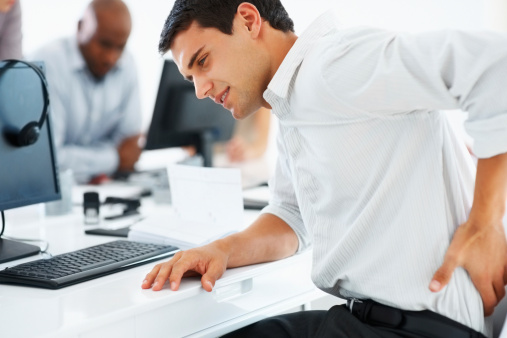 Before I begin, I’d like to mention that I have some surprising news that you may want to stand up for. That’s right, stand up; because what you are currently doing can be severely harming your health.
Before I begin, I’d like to mention that I have some surprising news that you may want to stand up for. That’s right, stand up; because what you are currently doing can be severely harming your health.
Years ago, our ancestors’ average day consisted of hunting (or running from) wild animals, gathering foods to eat, or tending to crops. As our species evolved, our society has shifted to a much more sedentary lifestyle. Gone are the days of working the fields and cultivating crops. Today, the majority of North Americans spend their day sitting behind a desk in front of a computer screen or on a couch watching TV; this has been an inevitable shift caused by the digital revolution.
Advertisement
The result of this shift has us sitting for a large portion of our day. On average, people spend over eight hours a day sitting; that’s more time than the average person spends sleeping. Unfortunately, many studies are now suggesting that sitting can be one of the worst activities (or lack thereof) that contributes to many of the health issues we currently suffer from.
A Deadly Posture
The problem with sitting is that humans were not built to do it for extended periods of time. The concept of sitting for hours on end has only taken root in the last half-century or so, and the impact on our health is widespread. A study conducted by the American Cancer Society found that people who sat for more than six hours a day had a 40 percent higher chance of dying in the next 15 years, compared to someone who sat for three hours a day or less. A similar study found that people who sit for more than six hours a day see a decrease in their quality of life by seven years.
Many people are aware that a sedentary lifestyle is unhealthy and can lead to weight gain or cardiovascular problems. However, contrary to popular belief, exercising seems to have very little impact on a person’s health if the majority his or her time is spent sitting. As your doctor, it’s important that I explain to you the consequences of sitting for too long, and how you can reverse these effects.
The Uncomfortable Truth About Sitting
Scientists have spent many years establishing what happens to a person’s body when they sit. They found that sitting ultimately affects every part of a person’s body, both internally an externally.
Back Pain: Almost every person has complained of back pains after sitting for too long.
- Scientists have found that the connective tissue that coats our muscles tends to take the shape our bodies most commonly hold.
- By sitting for an extended period of time, we force our backs to conform to an uncomfortable hunched position that severely hinders our posture.
- Sitting also forces our hips and pelvis to tilt forward, which puts an immense amount of stress on our lower spine.
Hip Pain: If you’ve ever experienced discomfort in your hips, it’s largely a result of sitting for too long.
- Sitting causes the muscles above your thighs (hip flexors) to contract unnaturally, forcing them into a bent position.
- The overall result is a joint and hip pain that leads people to hunch over uncomfortably.
- People who cross their legs while sitting can experience hip imbalances, which impact both posture and agility.
Weight Gain: Perhaps the most obvious part of our bodies—the one on which the sitting happens—is the one that suffers most.
- The gluteus muscles are the largest muscle group of your body.
- Sitting prevents your gluteus muscles from firing and burning calories.
- The lack of calorie burning can lead to weight gain, as well as weakened muscles that prevent you from exercising, lifting, or even walking properly.
Headaches: Unfortunately, the upper body is not spared from the side-effects of sitting at a desk.
- When people sit in front of a computer their back and shoulders hunch over the keyboard as they type.
- The International Headache Society has linked sitting and poor posture as a lead cause of tension-type headaches, the most prevalent headache complaint amongst Americans.
If you’re starting to shift in your seat, it might be time for a stretch. However, while the physical effects of sitting can be uncomfortable, the hidden effects are far more dangerous.
Immediate Effects of Sitting:
- The British Journal of Sports Medicine notes that the moment your posterior hits the chair, the electrical activity in your legs turn off.
- The enzyme lipoprotein lipase (LPL)—an enzyme responsible for breaking down fat in your bloodstream—drops significantly upon sitting, which can lead to weight gain.
- Shortly after sitting your insulin levels (and their effectiveness) drop by 40 percent, which leads to an increased risk of developing Type-2 diabetes.
Cardiovascular: Perhaps even more alarming is the long-term effect that sitting has on cardiovascular health.
- When we sit, our muscles relax, which leads to a decrease in enzyme activity.
- This drop in enzyme activity leads to a significant increase of LDL (“bad” cholesterol), and a 20 percent decrease of HDL (“good” cholesterol).
- A study conducted by the Pennington Biomedical Research Center found that those who sat for the majority of the work day were 54 percent more likely to suffer from cardiovascular disease than those who were active.
Taken into perspective, these effects are a catalyst to change our behaviors. After explaining the consequences of sitting to my patients, many of them point out that they exercise regularly after work, believing that they are “safe” from the dangers. Unfortunately, countless studies have shown that exercise cannot reverse the effects of a sedentary lifestyle. That solution would be akin to putting a band-aid on your head to heal a headache; the two are not related. In order to mitigate the effects of extended sitting, there are a number of practical changes that must be made.
Stand up For Your Health
Advertisement
It’s time to take a break. Get up, stretch your legs, and shake it out. While the effects of sitting at your desk all day long are frightening, you can take a few simple steps (literally) to improve your health. Here are some simple, effective steps you can take to reduce the negative effects of sitting:
- Instead of sitting, stand. Standing helps to increase energy levels, burn more calories, improve metabolism, and increase blood flow through the body. Standing at every chance you have (while at the computer, watching TV, talking on the phone, etc.) will help counter the effects of sitting.
- Take frequent breaks. Studies have shown that taking frequent, measured breaks to stand and move around throughout the day is the easiest and most effective way to fight a sedentary lifestyle. Set a reminder on your computer to go off every hour, forcing you to get up, move around, and stretch for at least two minutes.
- Every step counts. Many people complain that they don’t have enough time to get the minimum 30-minutes of exercise recommended. An effective solution is to break these exercises into small chunks. Some easy ways to implement this include: getting off the bus or train a stop early and walking the rest of the way; parking as far as you can from your office; taking the stairs instead of the elevator; walking to speak to a colleague instead of emailing them; increasing your fluid consumption to encourage more walks to the washroom; and even getting up and performing chores during TV commercial breaks.
- Stand to work. Implement a work environment that’s more conducive to standing. Ask your employer to institute standing workstations instead of the traditional desk and chair. Institute “walking meetings” in which meetings are held while employees walk outside. Take stretch breaks with a colleague and encourage one another to move throughout the day.
- Put Up Your Feet. The standard office chair does not offer enough hip, spine, and neck support. However, sitting at a 135º incline is the best posture to put less strain on your body—even better than sitting straight.
While you may now be worried about the effects that sitting has had on your body, remember that you are sitting in the driver’s seat and you hold the key to your health. Make sure to reverse the effects of sitting by adopting a more active lifestyle, take more frequent breaks to stand, walk, and move more to improve your overall health.

